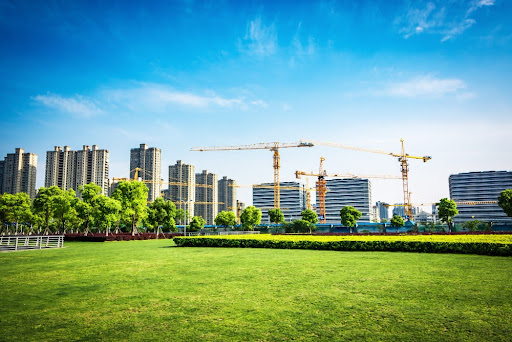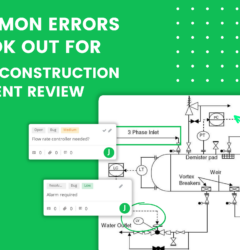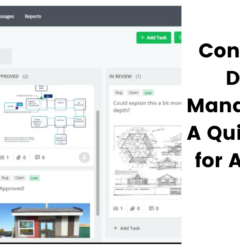The Why and How of Prioritizing Sustainable Construction
06 Feb

Table of Contents
ToggleIn an era marked by growing environmental concerns and the pressing need to address climate change, the construction industry faces a critical moment. The way we build has a significant impact on the planet’s sustainability. Therefore, embracing sustainable construction isn’t optional; it’s a need to build a greener, stronger future.
On one hand, it provides the infrastructure that drives economic growth and human well-being. On the other, its practices significantly contribute to climate change, resource depletion, and environmental degradation.
By adopting sustainable construction methods and leveraging tools like zipBoard, teams can enhance operational efficiency, streamline pre-construction planning, and reduce material waste, adding to a greener environment. In this scenario, prioritizing sustainable construction is now a necessity rather than a choice.
Understanding the Importance of Sustainable Construction
Sustainable construction, also known as green or eco-friendly building, focuses on natural obligation and resource efficiency throughout the building’s lifecycle. It encompasses design, construction, operation, maintenance, and even demolition or deconstruction.
Beyond environmental protection, sustainable construction has other advantages. Some economic benefits include lower operating costs, improved occupant well-being, and social benefits like enhanced community resilience and equity.
Here’s why sustainable construction is important:
- Environmental Stewardship: Sustainable construction practices mitigate environmental degradation by fossil fuel byproducts, conserving resources, and limiting pollution, thus protecting biological systems and biodiversity.
- Economic Viability: Sustainability promotes economic resilience and competitiveness by driving long-term cost savings through improved energy efficiency, decreased operational expenses, and potential financial incentives.
- Social Well-being: It prioritizes occupant well-being and comfort by establishing healthier indoor environments supported by tools like air quality sensors, promoting community resilience, and fostering equitable access to safe and sustainable infrastructure.
- Resource Conservation: By focusing on the utilization of renewable materials, and innovative construction techniques, sustainable construction minimizes resource depletion, conserves natural habitats, and promotes circular economy principles.
- Regulatory Compliance and Market Demand: Complying with sustainable construction standards and certifications guarantees compliance with regulations and meets the rising need for green buildings from environmentally conscious consumers, improving market competitiveness and securing future investments.
The importance of sustainable construction lies in its ability to mitigate environmental effects, drive economic efficiency, and promote social well-being, eventually paving the way for a more sustainable and resilient future.
The "Why" of Prioritizing Sustainable Construction
Sustainable construction is a necessity driven by environmental impact, economic benefits, and social responsibility. It also addresses critical pre-construction challenges like ensuring document accuracy, minimizing errors, and improving stakeholder communication. Let’s delve into the compelling reasons that drive the adoption of eco-friendly practices in building projects.
Learn how collaborative review tools can help your team prioritize sustainability
Try zipBoard for FreeManage and collaborate on construction documents in zipBoard to reduce paper-based processes.
1. Environmental impact
The construction industry is a major contributor to environmental degradation, accounting for a portion of global pollution, resource depletion, and emissions of greenhouse gases.
Unsustainable construction practices exacerbate climate change, accelerate biodiversity loss, and pose significant public health risks. Hence, recognizing and mitigating these impacts is fundamental for cultivating a sustainable future.
For instance, using collaborative platforms such as zipBoard can help construction teams manage project documents and coordinate changes effectively. This reduces rework, saving resources and decreasing the overall environmental footprint.
Early identification of documentation errors through effective construction document review processes can minimize waste from incorrect material usage or demolition.
2. Economic benefits
Sustainable construction provides significant long-term cost savings by improving energy efficiency, reducing material waste, and implementing low-maintenance solutions.
Moreover, tools like zipBoard ensure that all stakeholders are aligned during the pre-construction phase, avoiding costly delays or miscommunications.
Additionally, green certifications such as LEED often require meticulous documentation, which can be streamlined through collaborative review platforms.
3. Social responsibility
Beyond economic considerations, sustainable construction underscores the ethical responsibility of the industry to safeguard the environment and promote social well-being. Promoting community resilience, improving occupant comfort and safety, and ensuring healthy indoor environments are all part of social responsibility.
Stakeholders not only meet their ethical responsibilities by prioritizing sustainable construction, but they also contribute to the development of healthier, more equitable communities for present and future generations.
In this way, by understanding and addressing key reasons, partners can drive significant change toward a more sustainable and resilient built environment.
One way to ensure this is achieved is fostering better collaboration among project teams. And zipBoard empowers stakeholders to prioritize occupant comfort, safety, and healthy indoor environments. Incorporating essential safety training programs, such as OSHA scaffold competent person training, further reinforces this commitment. This contributes to the development of equitable and resilient communities.
The "How" of Prioritizing Sustainable Construction
Implementing sustainable construction practices requires a thorough approach that spans material selection, design, construction techniques, operational effectiveness, collaboration, and advocacy. Let’s look at practical ways to put sustainability first in construction projects.

1. Material selection
Picking the right materials is primary to sustainable construction. Recycled, locally sourced, and renewable options like bamboo and timber promote resource efficiency and reduce environmental impact.
For instance, reclaimed wood minimizes waste as well as adds unique character to a project. Similarly, using bamboo—a fast-growing renewable resource—offers strength and flexibility while reducing carbon emissions associated with traditional materials like steel or concrete.
Tools like zipBoard can simplify this process by enabling real-time feedback and documentation during material selection, ensuring that sustainable choices are properly vetted and approved by all stakeholders.
2. Design and construction techniques
Sustainable construction relies heavily on efficient design and construction methods. Energy consumption and operating expenses can be significantly reduced by incorporating energy-efficient design principles like maximizing natural lighting, using passive heating and cooling strategies, and optimizing the performance of the building envelope.
Green building rating systems like LEED (Leadership in Energy and Environmental Design) provide guidelines for sustainable design and construction, guiding practitioners toward environmentally responsible practices and certification.
By using platforms like zipBoard, construction teams can collaborate effectively during the design phase, ensuring alignment on these energy-saving features. Integrated workflows reduce the risk of misinterpretation and costly design rework.
3. Operational efficiency
Beyond the construction phase, operational efficiency is vital for maintaining sustainable buildings.
Utilizing renewable energy sources like solar panels, conserving water, and installing appliances and systems that use less energy all contribute to long-term sustainability and cost savings. Additionally, using final mile delivery solutions can help enhance operational efficiency.
Furthermore, regular monitoring and maintenance practices guarantee that buildings continue to perform optimally, limiting energy waste and maximizing environmental benefits.
4. Collaboration and advocacy
For sustainability to be successfully integrated into construction projects, stakeholders — architects, engineers, contractors, and clients—must work together. Teams can use diverse expertise to implement holistic sustainable solutions by encouraging open communication and goals that are shared.
zipBoard facilitates seamless collaboration by enabling teams to annotate, review, and approve documents and submittals in real time, fostering transparency and accountability. This ensures all stakeholders have a clear understanding of project goals and sustainability benchmarks.
Plus, advocating for sustainable practices through clear communication and documentation also builds strengthens client relationships and positions companies as leaders in green construction.
Looking to streamline your collaboration processes for greener results?
Book a zipBoard Demo TodayConclusion
Sustainable construction isn’t just a trend; it’s a fundamental shift toward a more responsible and resilient built environment. By focusing on sustainability in construction practices, we can mitigate the environmental impacts of building construction and operation while creating healthier, more livable spaces for current and future generations.
Innovation, collaboration, and commitment to environmental stewardship are key to this transformation. Collaborative tools like zipBoard enable teams to streamline workflows, improve document accuracy, and foster transparency, ensuring sustainability goals are achieved efficiently.
Take the first step toward smarter collaboration.
Book a zipBoard Demo today and see how we can help your team meet sustainability goals while saving time and resources.
Book DemoStart Free Trial
Author’s bio:
Emily Thompson, the Senior Content Specialist at Upper, introduces a game-changing route optimization software. With her tech-savvy approach and storytelling, she has become a master at crafting compelling narratives that captivate audiences and drive results.
Recommended Readings
https://zipboard.co/blog/aec/construction-document-management-quick-guide-for-architects-firms/
https://zipboard.co/blog/aec/how-to-ensure-effective-collaboration-in-construction-document-reviews/
https://zipboard.co/blog/aec/how-to-optimize-communication-and-collaboration-in-construction-administration/
Recent Posts
- Why Your Team Needs a Content Feedback System (Not Just Comments in Docs) May 28, 2025
- Content Approvals Are Slowing You Down — Here’s the Fix May 26, 2025
- How to Streamline Content Review and Approval — Best Practices, Tools & Automation May 12, 2025
- What Is Content Operations? And Why It Breaks Without a Feedback & Approval System May 3, 2025
- Why Designers Need a Website Visual Feedback Tool: Improve Design Reviews & Client Collaboration April 25, 2025
©️ Copyright 2023 zipBoard Tech. All rights reserved.

